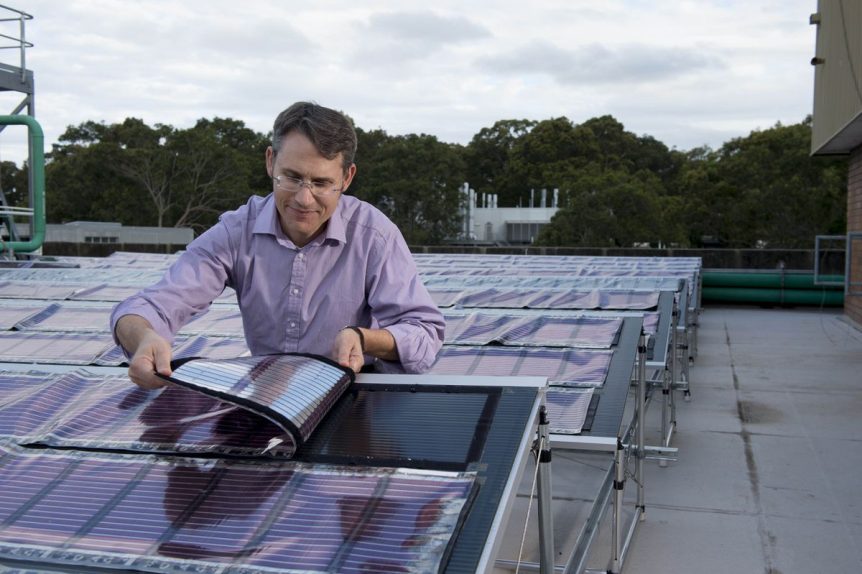University of Newcastle (UON) researchers may have achieved a breakthrough in creating solar cells on flexible plastic made in a roll-to-roll process with an unbelievably low price and equally incredible sensitivity. They seem to have succeeded where an American firm failed half a decade ago. Printed solar cells were first attempted about a decade ago, with Konarka trying to make solar cells on simple ink-jet printers. The company failed, despite having a Nobel Prize winner and other top physicist and chemists overseeing the process. The “cells” never achieved more than about four- or five-percent efficiency and their plastic substrate deteriorated rapidly. Today, The University of Newcastle in New South Wales, Australia, and CHEP, a client firm, are displaying their thin-cell, recyclable plastic solar film that can be stuck to things with double-sided tape. Used initially to monitor response to different solar conditions, the recently-installed film shows some highly-desirable characteristics. Professor Paul Dastoor claims, “Our printed solar solution continues to function …
Solar Sails for Ultralights?
Ultralights have done many spectacular things, including topping Mt. Everest and crossing the English Channel. Gerard Thevenot flew the Channel under a La Mouette wing powered by an Eck/Geiger motor driven by three fuel cells in 2009 – six years before the recent flights with faster electric craft. For that matter, Paul MacCready and his team flew a solar-powered aircraft from near Paris to an RAF runway on the eastern English coast in 1981. Hang gliders, paramotors, and other rigid and non-rigid-wing craft might benefit from new sailcloth that incorporates flexible solar cells into its makeup. Used on sailboats, the solar fabric helps run auxiliary motors and can help extend the cruising range of a boat when the sails are furled. A French company named UK Sailmakers France has started a new company, SolarClothSystem®, to make mainsails with “a film containing high efficiency photovoltaic cells.” The solar cells can be used on sails that will be rolled or folded, as …
A Layer of Graphene, A Layer of Nanowires…
Combine nano-anything with graphene, and that seems to describe most of what’s driving physics and chemistry laboratories at our major universities. The blog reported last week on Princeton researchers who’ve created a thin, flexible solar cell that absorbs 96-percent of received light and draws energy from off-axis and varied wavelengths of light. MIT researchers, too, have created a thin, flexible solar cell, but one based on layers of flexible graphene sheets, each coated with a layer of nanowires. Besides flexibility, these sheets offer transparency, enabling their use on windows as well as other surfaces. David Chandler, reporting for MIT states that the new cells may prove to be far less expensive than today’s silicon equivalents, which require high-purity silicon that undergoes crystallization and extremely thin slicing. Alternatives use indium tin oxide (ITO), itself an expensive substitute for or adjunct to silicon. Nanostructured cells such as that from Princeton may allow lower-priced material, although one version uses a gold foil top layer. Silvija …

